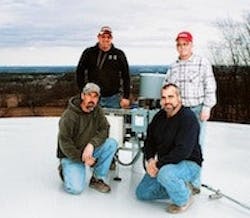Upstate New York Town Cuts THMs in Potable Water System
Concerned about levels of trihalomethanes (THMs) in the town’s potable water storage tank, water utility officials in York, N.Y., took advantage of a tank rehab project to assess their options. The overall goal was to provide high-quality drinking water, while also meeting the U.S Environmental Protection Agency (EPA) Stage 2 Disinfectants and Disinfection Byproduct Rule (DBPR) of 80 micrograms per liter (ug/l) or less at the last point of distribution. Although they considered designing their own solution, York officials instead chose a GridBee fully engineered THM removal system from Medora Corp. that was reliable and affordable and also provided complete installation, maintenance and support.
York, located on the western edge of the Finger Lakes and 30 miles south of Rochester, N.Y., provides water to about 1,000 residents plus several dairy farms, light manufacturing operations and the famous Genesee Abbey Monks’ Bread bakery. “We’re all about quality of life here. And it starts with quality of water,” said George Worden, overseer of water and sewer operations for York.
Problem: Water High in THMs
York purchases its water from a neighboring town, which chlorinates lake water and stores it in concrete ponds before sending it to York. “In order to provide the safest water, we realized that we had to treat our water to eliminate the THMs created at the disinfection point,” Worden said. “The water we receive can already be high in THMs due to chlorine reacting with the lake water’s natural organic material.” Although the water supplier installed an activated charcoal filter system (replacing the original sand filter), York needed something of its own to keep THMs at an acceptable level.
York has two 750,000-gal tanks and 37 miles of water mains. “Our primary goal was to meet the EPA requirement of 80 ug/l throughout the distribution system. We also had taste and odor issues, as the lake water can sometimes get ‘seaweedy,’” Worden said.
York’s water utility team members tend to be do-it-yourselfers, and their original plan was to design a THM removal system for the east tank, the one undergoing repairs. “We considered building our own unit, but we soon realized that it would be better to have a solid manufacturer behind the project, not only for performance, but also to make sure that we would have proper installation and support for the long run,” Worden said. “And, from our research, we understood that mixing should help us get good-quality water.
“After consulting with our engineer, we decided that the GridBee system could provide the most [greatest] percent reduction at the tank, no matter what came in from the supplier. Medora provided the strongest evidence of being able to do the job and provide the best support after startup.”
Solution: Pre-engineered System
The GridBee mixer from Medora combines mixing and air-stripping technologies to strip THMs from the water and purge them through a venting system. A submersible pump pushes water through the spray nozzles, where THMs are volatilized and removed from the water through rooftop vents. York also purchased a GridBee GS-12 submersible mixer, which ensures that the water exiting the spray nozzles is well-mixed with the remaining water in the tank. This reduces stratification and solves the taste and odor issues. During the winter, the spray nozzle function can be switched off, but the mixer can still operate to prevent ice damage in the tank. The entire spray nozzle THM removal system is portable and prepackaged for easy installation.
“Spray nozzles are a proven technology for removing volatile organic compounds, and we designed this economical system specifically for municipalities whose budgets are already stretched,” said Joel Bleth, president, SolarBee. “And, the spray nozzle system is scalable to fit the customer’s application.”
“All we had to do was add electricity,” Worden said.
Result: THMs Reduced 62%
York’s twin tanks (east and west) served as useful comparisons. Both tanks measured the same amount of THMs in inflow water. The west tank, without the GridBee system, had no change in THM level in outflow water. The GridBee-equipped east tank measured a 62% reduction in THMs in outflow water, which easily meets the EPA rule. These measurements were taken in the fall shortly after the GridBee mixer was installed. York anticipates similar percentage decreases in the summer since THM levels are typically higher during warmer weather and higher at the last distribution point as water travels through the pipes.
“It's more than compliance,” Worden said. “We want to have a safe quality of life for our community.”
Bob Nobile is the marketing manager for Medora Corp. Nobile can be reached at [email protected] or 866.437.8076.
